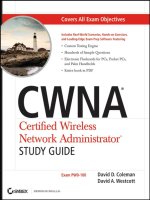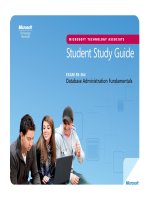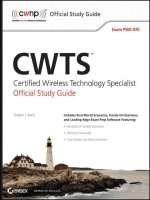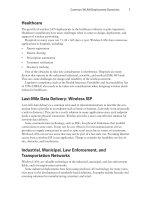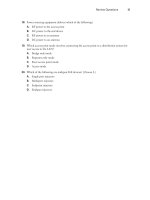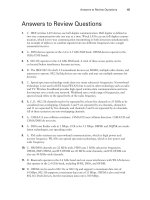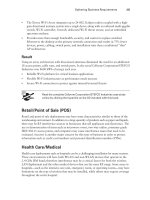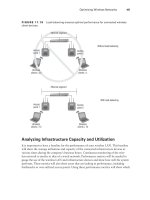CCENT cisco certified entry networking technician study guide exam 100 101 ICND1
Bạn đang xem bản rút gọn của tài liệu. Xem và tải ngay bản đầy đủ của tài liệu tại đây (16.65 MB, 642 trang )
Table of Contents
Cover
Acknowledgments
About the Author
Introduction
Cisco’s Network Certifications
What Does This Book Cover?
What’s Available Online?
How to Use This Book
Where Do You Take the Exams?
CCENT Exam Objectives
Assessment Test
Answers to Assessment Test
Chapter 1: Internetworking
Internetworking Basics
Internetworking Models
The OSI Reference Model
Summary
Exam Essentials
Written Labs
Review Questions
Chapter 2: Ethernet Networking and Data Encapsulation
Ethernet Networks in Review
Ethernet Cabling
Data Encapsulation
The Cisco Three-Layer Hierarchical Model
Summary
Exam Essentials
Written Labs
Review Questions
Chapter 3: Introduction to TCP/IP
Introducing TCP/IP
TCP/IP and the DoD Model
IP Addressing
IPv4 Address Types
Summary
Exam Essentials
Written Labs
Review Questions
Chapter 4: Easy Subnetting
Subnetting Basics
Summary
Exam Essentials
Written Labs
Review Questions
Chapter 5: VLSMs, Summarization, and Troubleshooting TCP/IP
Variable Length Subnet Masks (VLSMs)
Summarization
Troubleshooting IP Addressing
Summary
Exam Essentials
Written Lab 5
Review Questions
Chapter 6: Cisco’s Internetworking Operating System (IOS)
The IOS User Interface
Command-Line Interface (CLI)
Administrative Configurations
Router and Switch Interfaces
Viewing, Saving, and Erasing Configurations
Summary
Exam Essentials
Written Lab 6
Hands-on Labs
Review Questions
Chapter 7: Managing a Cisco Internetwork
The Internal Components of a Cisco Router and Switch
Backing Up and Restoring the Cisco Configuration
Configuring DHCP
Network Time Protocol (NTP)
Using Cisco Discovery Protocol (CDP)
Using Telnet
Resolving Hostnames
Checking Network Connectivity and Troubleshooting
Summary
Exam Essentials
Written Lab 7
Hands-on Labs
Review Questions
Chapter 8: IP Routing
Routing Basics
The IP Routing Process
Configuring IP Routing
Configuring IP Routing in Our Network
Dynamic Routing
Routing Information Protocol (RIP)
Summary
Exam Essentials
Written Lab 8
Hands-on Labs
Review Questions
Chapter 9: Open Shortest Path First (OSPF)
Open Shortest Path First (OSPF) Basics
Configuring OSPF
OSPF and Loopback Interfaces
Verifying OSPF Configuration
Summary
Exam Essentials
Written Lab 9
Hands-on Labs
Review Questions
Chapter 10: Layer 2 Switching
Switching Services
Configuring Catalyst Switches
Summary
Exam Essentials
Written Lab 10
Hands-on Labs
Review Questions
Chapter 11: VLANs and InterVLAN Routing
VLAN Basics
Identifying VLANs
Routing between VLANs
Configuring VLANs
Summary
Exam Essentials
Written Lab 11
Hands-on Labs
Review Questions
Chapter 12: Security
Perimeter, Firewall, and Internal Routers
Introduction to Access Lists
Standard Access Lists
Extended Access Lists
Monitoring Access Lists
Summary
Exam Essentials
Written Lab 12
Hands-on Labs
Review Questions
Chapter 13: Network Address Translation (NAT)
When Do We Use NAT?
Types of Network Address Translation
NAT Names
How NAT Works
Testing and Troubleshooting NAT
Summary
Exam Essentials
Written Lab 13
Hands-on Labs
Review Questions
Chapter 14: Internet Protocol Version 6 (IPv6)
Why Do We Need IPv6?
The Benefits and Uses of IPv6
IPv6 Addressing and Expressions
How IPv6 Works in an Internetwork
IPv6 Routing Protocols
Configuring IPv6 on Our Internetwork
Configuring Routing on Our Internetwork
Summary
Exam Essentials
Written Labs
Hands-on Labs
Review Questions
Appendix A: Answers to Written Labs
Chapter 1: Internetworking
Chapter 2: Ethernet Networking and Data Encapsulation
Chapter 3: Introduction to TCP/IP
Chapter 4: Easy Subnetting
Chapter 5: VLSMs, Summarization and Troubleshooting TCP/IP
Chapter 6: Cisco’s Internetworking Operating System (IOS)
Chapter 7: Managing a Cisco Internetwork
Chapter 8: IP Routing
Chapter 9: Open Shortest Path First (OSPF)
Chapter 10: Layer 2 Switching
Chapter 11: VLANs and InterVLAN Routing
Chapter 12: Security
Chapter 13: Network Address Translation
Chapter 14: Internet Protocol Version 6 (IPv6)
Appendix B: Answers to Review Questions
Chapter 1: Internetworking
Chapter 2: Ethernet Networking and Data Encapsulation
Chapter 3: Introduction to TCP/IP
Chapter 4: Easy Subnetting
Chapter 5: VLSMs, Summarization, and Troubleshooting TCP/IP
Chapter 6: Cisco’s Internetworking Operating System (IOS)
Chapter 7: Managing a Cisco Internetwork
Chapter 8: IP Routing
Chapter 9: Open Shortest Path First (OSPF)
Chapter 10: Layer 2 Switching
Chapter 11: VLANs and InterVLAN Routing
Chapter 12: Security
Chapter 13: Network Address Translation
Chapter 14: Internet Protocol Version 6 (IPv6)
Appendix C: Disabling and Configuring Network Services
Blocking SNMP Packets
Disabling Echo
Turning off BootP and Auto-Config
Disabling the HTTP Interface
Disabling IP Source Routing
Disabling Proxy ARP
Disabling Redirect Messages
Disabling the Generation of ICMP Unreachable Messages
Disabling Multicast Route Caching
Disabling the Maintenance Operation Protocol (MOP)
Turning Off the X.25 PAD Service
Enabling the Nagle TCP Congestion Algorithm
Logging Every Event
Disabling Cisco Discovery Protocol
Disabling the Default Forwarded UDP Protocols
Cisco’s Auto Secure
Appendix D: About the Additional Study Tools
Additional Study Tools
System Requirements
Using the Study Tools
Troubleshooting
Free Online Tools
Senior Acquisitions Editor: Jeff Kellum
Development Editor: Pete Gaughan
Technical Editors: John Swartz and Dennis Frye
Production Editor: Christine O’Connor
Copy Editor: Judy Flynn
Editorial Manager: Pete Gaughan
Production Manager: Tim Tate
Vice President and Executive Group Publisher: Richard Swadley
Vice President and Publisher: Neil Edde
Media Project Manager I: Laura Moss-Hollister
Media Associate Producer: Doug Kuhn
Media Quality Assurance: Marilyn Hummel
Book Designers: Judy Fung and Bill Gibson
Compositor: Craig Woods, Happenstance Type-O-Rama
Proofreaders: Sarah Kaikini and Josh Chase, Word One New York
Indexer: Robert Swanson
Project Coordinator, Cover: Katherine Crocker
Cover Designer: Ryan Sneed
Copyright © 2013 by John Wiley & Sons, Inc., Indianapolis, Indiana
Published simultaneously in Canada
ISBN: 978-1-118-74968-5
ISBN: 978-1-118-74950-0 (ebk.)
ISBN: 978-1-118-79158-5 (ebk.)
No part of this publication may be reproduced, stored in a retrieval system or transmitted in any form
or by any means, electronic, mechanical, photocopying, recording, scanning or otherwise, except as
permitted under Sections 107 or 108 of the 1976 United States Copyright Act, without either the prior
written permission of the Publisher, or authorization through payment of the appropriate per-copy fee
to the Copyright Clearance Center, 222 Rosewood Drive, Danvers, MA 01923, (978) 750-8400, fax
(978) 646-8600. Requests to the Publisher for permission should be addressed to the Permissions
Department, John Wiley & Sons, Inc., 111 River Street, Hoboken, NJ 07030, (201) 748-6011, fax
(201) 748-6008, or online at />Limit of Liability/Disclaimer of Warranty: The publisher and the author make no representations or
warranties with respect to the accuracy or completeness of the contents of this work and specifically
disclaim all warranties, including without limitation warranties of fitness for a particular purpose. No
warranty may be created or extended by sales or promotional materials. The advice and strategies
contained herein may not be suitable for every situation. This work is sold with the understanding that
the publisher is not engaged in rendering legal, accounting, or other professional services. If
professional assistance is required, the services of a competent professional person should be sought.
Neither the publisher nor the author shall be liable for damages arising herefrom. The fact that an
organization or Web site is referred to in this work as a citation and/or a potential source of further
information does not mean that the author or the publisher endorses the information the organization or
Web site may provide or recommendations it may make. Further, readers should be aware that
Internet Web sites listed in this work may have changed or disappeared between when this work was
written and when it is read.
For general information on our other products and services or to obtain technical support, please
contact our Customer Care Department within the U.S. at (877) 762-2974, outside the U.S. at (317)
572-3993 or fax (317) 572-4002.
Wiley publishes in a variety of print and electronic formats and by print-on-demand. Some material
included with standard print versions of this book may not be included in e-books or in print-ondemand. If this book refers to media such as a CD or DVD that is not included in the version you
purchased, you may download this material at . For more information
about Wiley products, visit www.wiley.com.
Library of Congress Control Number: 2013941604
TRADEMARKS: Wiley, the Wiley logo, and the Sybex logo are trademarks or registered trademarks
of John Wiley & Sons, Inc. and/or its affiliates, in the United States and other countries, and may not
be used without written permission. CCENT is a registered trademark of Cisco Technology, Inc. All
other trademarks are the property of their respective owners. John Wiley & Sons, Inc. is not
associated with any product or vendor mentioned in this book.
10 9 8 7 6 5 4 3 2 1
Dear Reader,
Thank you for choosing CCENT Study Guide. This book is part of a family of premium-quality
Sybex books, all of which are written by outstanding authors who combine practical experience with
a gift for teaching.
Sybex was founded in 1976. More than 30 years later, we’re still committed to producing
consistently exceptional books. With each of our titles, we’re working hard to set a new standard for
the industry. From the paper we print on, to the authors we work with, our goal is to bring you the
best books available.
I hope you see all that reflected in these pages. I’d be very interested to hear your comments and get
your feedback on how we’re doing. Feel free to let me know what you think about this or any other
Sybex book by sending me an email at If you think you’ve found a technical error
in this book, please visit . Customer feedback is critical to our efforts at
Sybex.
Best regards,
Neil Edde
Vice President and Publisher
Sybex, an Imprint of Wiley
Acknowledgments
There are many people that work to put a book together, and although as an author I dedicate an
enormous amount of time to write the book, it would never be published without the dedicated, hard
work of many other people.
Monica Worthy Lammle was crucial to the finished product this book has become, going over every
word of every chapter with me to fine tune the language, and grammar. Without Monica’s guidance
and patience, I’d never have finished writing this book.
Next in line to thank was my new technical editor, John Swartz, who also co-authored the CCNA
Data Center Study Guide with me. His expertise in the Cisco technical field, and his history of
networking in general, is second to none. His detailed analysis of my work helped make this my best
CCENT Study Guide ever. Thank you, John, for working hard under pressure, with tight deadlines,
and for staying the course of delivering high-quality work in a short time frame.
Jeff Kellum, my acquisitions editor, is instrumental to my success in the Cisco world. Jeff, I look
forward to our continued progress together in the Cisco certification world.
Christine O’Connor, my production editor, and Judy Flynn, my copy editor, are my rock and
foundation for formatting and intense editing of every page in this book. This amazing team gives me
the confidence to help me keep moving during the difficult and very long days, week after week. How
Christine stays so organized with all my enormous amount of changes as well as making sure every
figure is in the right place in the book is still a mystery to me! You’re amazing, Christine! Thank you!
Judy understands my writing style so well now, after doing at least a dozen books with me, she can
tell when I made a technical error that I may have missed when previously going through the material.
Thank you, Judy, for doing such a great job! I truly thank you both.
Troy McMillian: Troy has become my de facto writer, technical editor, and researcher, and he
always comes through on any unreasonable deadline. I always look forward to working with Troy.
Jim Frye is my admin and student liaison at GlobalNet Training, and he was instrumental in taking
my figures that I created and making them a masterpiece. Thank you, Jim!
Finally, a big thanks to Craig Woods at Happenstance-Type-O-Rama, proofreaders Josh Chase and
Sarah Kaikini, indexer Robert Swanson, and to the Sybex media-development team.
About the Author
Todd Lammle is the Authority on Cisco Certification and internetworking. He is a world-renowned
author, speaker, trainer, and consultant. Todd has three decades of experience working with LANs,
WANs, and large licensed and unlicensed wireless networks, and lately he has been implementing
large Cisco data centers worldwide. His three decades of real world experience is prevalent in his
writing; he is not just an author but an experienced networking engineer with very practical
experience working on the largest networks in the world. Todd has published over 60 books,
including the very popular CCNA: Cisco Certified Network Associate Study Guide, CCNA Wireless
Study Guide, and CCNA Data Center Study Guide, all from Sybex. He runs an international training
and consulting company based in Colorado, Texas, and San Francisco.
You can reach Todd through his forum and blog at www.lammle.com.
Introduction
Welcome to the exciting world of Cisco certification! If you’ve picked up this book because you want
to improve yourself and your life with a better, more satisfying and secure job, you’ve done the right
thing. Whether you’re striving to enter the thriving, dynamic IT sector or seeking to enhance your
skillset and advance your position within it, being Cisco certified can seriously stack the odds in your
favor to help you attain your goals!
Cisco certifications are powerful instruments of success that also markedly improve your grasp of
all things internetworking. As you progress through this book, you’ll gain a complete understanding of
networking that reaches far beyond Cisco devices. By the end of this course, you’ll comprehensively
know how disparate network topologies and technologies work together to form the fully operational
networks that are vital to today’s very way of life in the developed world. The knowledge and
expertise you’ll gain here is essential for and relevant to every networking job and is why Cisco
certifications are in such high demand—even at companies with few Cisco devices!
Although it’s now common knowledge that Cisco rules routing and switching, the fact that it also
rocks the voice, data center, and service provider world is also well recognized. And Cisco
certifications reach way beyond the popular but less extensive certifications like those offered by
CompTIA and Microsoft to equip you with indispensable insight into today’s vastly complex
networking realm. Essentially, by deciding to become Cisco certified, you’re proudly announcing that
you want to become an unrivaled networking expert—a goal that this book will get you well on your
way to achieving. Congratulations in advance to the beginning of your brilliant future!
For up-to-the-minute updates covering additions or modifications to the Cisco
certification exams, as well as additional study tools, review questions, and bonus
material, be sure to visit the Todd Lammle websites and forum at www.lammle.com,
www.lammlesim.com, www.lammle.com/forum, or the book’s web page at
www.sybex.com/go/ccentsg.
Cisco’s Network Certifications
It used to be that to secure the holy grail of Cisco certifications—the CCIE—you passed only one
written test before being faced with a grueling, formidable hands-on lab. This intensely daunting, allor-nothing approach made it nearly impossible to succeed and predictably didn’t work out too well
for most people. Cisco responded to this issue by creating a series of new certifications, which not
only made it easier to eventually win the highly coveted CCIE prize, it gave employers a way to
accurately rate and measure the skill levels of prospective and current employees. This exciting
paradigm shift in Cisco’s certification path truly opened doors that few were allowed through before!
Beginning in 1998, obtaining the Cisco Certified Network Associate (CCNA) certification was the
first milestone in the Cisco certification climb as well as the unofficial prerequisite to each of the
more advanced levels. But that changed when Cisco announced the Cisco Certified Entry Network
Technician (CCENT) certification. And then in March 2013, Cisco once again proclaimed that allnew tests will be required beginning in October of the same year; now the Cisco certification process
looks like Figure I-1.
Figure I-1: The Cisco Certification Path
I have included only the most popular tracks in Figure I-1. In addition to the ones in this
image, there are also tracks for Design, Service Provider, Service Provider Operations,
and Video. Also note that the CCIE Voice certification will retire in February 2014.
The Cisco Routing and Switching (R/S) path is by far the most popular and could very well remain
so, but soon you’ll see the Data Center path become more and more of a focus as companies migrate
to data center technologies. The Voice track also actually does provide a good job opportunity. Still,
understanding the foundation of R/S before attempting any other certification track is something I
highly recommend.
Even so, and as the figure shows, you only need your CCENT certification to get underway for most
of the tracks. Also, note that there are a few other certification tracks you can go down that are not
shown in the figure, although they’re not as popular as the ones shown. You can find information on
all Cisco certification tracks at www.cisco.com.
Cisco Certified Entry Network Technician (CCENT)
Don’t be fooled by the oh-so misleading name of this first certification because it absolutely isn’t!
Okay—maybe entry level for Cisco’s certification path, but definitely not for someone without
experience trying to break into the highly lucrative yet challenging IT job market! For the uninitiated,
the CompTIA A+ and Network+ certifications aren’t official prerequisites, but know that Cisco does
expect you to have that type and level of experience before embarking on your Cisco certification
journey.
All of this gets us to 2013, when the climb to Cisco supremacy just got much harder again. The
innocuous-sounding siren’s call of the CCENT can lure you to some serious trouble if you’re not
prepared, because it’s actually much harder than the old CCNA ever was. This will rapidly become
apparent once you start studying, but be encouraged! The fact that the certification process is getting
harder really works better for you in the long run, because that which is harder to obtain only
becomes that much more valuable when you finally do, right? Yes, indeed!
One important factor to keep in mind is that the CCENT requires you to only pass one exam:
Interconnecting Cisco Network Devices Part I (number 100-101 exam), which this book was written
for. The exam costs $150 per attempt, but is very difficult to pass! The good news is that this book
will guide you step-by-step in building a strong foundation in routing and switching technologies. You
really need to build on a strong technical foundation and stay away from exam cram type books,
suspicious online material, and the like. They can help somewhat, but understand that you’ll pass the
Cisco certification exams only if you have a strong foundation and that you’ll get that solid foundation
only by reading as much as you can, performing the written labs and review questions in this book,
and practicing lots and lots of hands-on labs. Additional practice exam questions, videos, and labs
are offered on my website, and what seems like a million other sites offer additional material that can
help you study.
However, there is one way to skip the CCENT exam and still meet the prerequisite required before
moving on to any other certification track, and that path is through the CCNA R/S Composite exam.
Cisco Certified Network Associate Routing and
Switching (CCNA R/S)
Once you have achieved your CCENT certification, you can take the ICND2 (200-101) exam in order
to achieve your CCNA R/S certification. This is now the most popular certification Cisco has by far
because it’s the most sought-after certification of all employers.
As with the CCENT, the ICND2 exam is also $150 per attempt—although thinking you can just
skim a book and pass any of these exams would probably be a really expensive mistake! The
CCENT/CCNA exams are extremely hard and cover a lot of material, so you have to really know
your stuff. Taking a Cisco class or spending months with hands-on experience is definitely a
requirement to succeed when faced with this monster!
Sybex is also publishing a book for the ICND2 exam. Visit
www.sybex.com/go/cccnaicnd2 for details.
And once you have your CCNA, you don’t have to stop there—you can choose to continue and
achieve an even higher certification, called the Cisco Certified Network Professional (CCNP). There
are various ones as shown in Figure I-1. The CCNP R/S is still the most popular, with Voice
certifications coming in at a close second. And I’ve got to tell you that the Data Center certification
will be catching up fast. Also good to know is that anyone with a CCNP has all the skills and
knowledge needed to attempt the notoriously dreaded but coveted CCIE lab. But just becoming a
CCENT/CCNA can land you that job you’ve dreamed about and that’s what this book is all about:
helping you to get and keep a great job!
Still, why take two exams to get your CCNA if you don’t have to? Cisco still has the Composite
exam 200-120 that, if passed, will land you with your CCENT and your CCNA R/S via only one test
priced accordingly at $300. Some people like the one test approach, some people like the two-test
approach, but this book will help you with either path you choose.
For details on Sybex’s CCNA Routing and Switching Study Guide, visit
www.sybex.com/go/cccna_r_ssg.
Why Become a CCENT and CCNA R/S?
Cisco, like Microsoft and other vendors that provide certification, has created the certification
process to give administrators a set of skills and to equip prospective employers with a way to
measure those skills or match certain criteria. And as you probably know, becoming a CCENT or
CCNA R/S is certainly the initial, key step on a successful journey toward a new, highly rewarding,
and sustainable networking career.
The CCENT and CCNA programs are created to provide a solid introduction not only to the Cisco
Internetwork Operating System (IOS) and Cisco hardware but also to internetworking in general,
making it helpful to you in areas that are not exclusively Cisco’s. And regarding today’s certification
process, it’s not unrealistic that network managers—even those without Cisco equipment—require
Cisco certifications for their job applicants.
Rest assured that if you make it through the CCENT and CCNA and are still interested in Cisco and
internetworking, you’re headed down a path to certain success!
What Skills Do You Need to Become a CCENT?
As stated above, to earn your CCENT, you need to pass the Interconnecting Cisco Network Devices,
Part I exam, number 100-101. This exam tests a candidate for the knowledge and skills required to
successfully install, operate, and troubleshoot a small branch office network.
The exam includes topics on the operation of IP data networks, LAN switching technologies, IPv6,
IP routing technologies, IP services (DHCP, NAT, ACLs), network device security, and basic
troubleshooting.
What Skills Do You Need to Become a CCNA R/S?
If you already have your CCENT and want to become a CCNA in Routing and Switching, you only
need to take the Interconnecting Cisco Network Devices Part 2 exam (number 200-101). This exam
tests a candidate for the knowledge and skills required to successfully install, operate, and
troubleshoot a small to medium-size enterprise branch network. The exam includes topics on LAN
switching technologies, IP routing technologies, IP services (FHRP, syslog, SNMP v2 and v3),
troubleshooting, and WAN technologies.
How Do You Become a CCNA R/S with Just One Test?
If you don’t want to take two exams and want to earn your CCNA, you have another option: passing
the CCNA Composite exam (number 200-120).
The way to become a CCNA R/S is to pass one little test (CCNA Composite exam 200-120)
without having to take the CCENT exam. Then—poof!—you’re a CCNA R/S. Oh, but don’t you wish
it were that easy? True, it’s just one test, but it’s a whopper, and to pass it you must possess enough
knowledge to understand what the test writers are saying.
I can’t stress this point enough: It’s critical that you have some hands-on experience with Cisco
routers. If you can get a hold of some basic routers and switches, you’re set; but if you can’t, I’ve
worked hard to provide hundreds of configuration examples throughout this book to help network
administrators, or people who want to become network administrators, learn the skills they need to
pass the CCENT and CCNA exams. In addition, a simulator called LammleSim IOS Version is
available for free with the purchase of this book. This small simulator will run through all the handson labs found in this book—nice huh?
For Cisco certification hands-on training with Todd Lammle, please see
www.lammle.com. Each student will get hands-on experience by configuring at least
three routers and two switches—no sharing of equipment!
What Does This Book Cover?
This book covers everything you need to know to pass the CCENT (ICND1) 100-101 exam. But as
I’ve said, taking plenty of time to study and practice with routers or a router simulator is the real key
to success.
You will learn the following information in this book:
Chapter 1: Internetworking You will learn the basics of the Open Systems Interconnection (OSI)
model the way Cisco wants you to learn it. There are written labs and plenty of review questions to
help you. Do not even think of skipping the fundamental written labs in this chapter!
Chapter 2: Ethernet Networking and Data Encapsulation This chapter will provide you the
Ethernet foundation you need in order to pass both the CCENT and CCNA exams. Data
encapsulation is discussed in detail in this chapter as well. And as with the other chapters, this
chapter includes written labs and review questions to help you.
Chapter 3: Introduction to TCP/IP This chapter provides you with the background necessary for
success on the exam as well as in the real world with a thorough presentation of TCP/IP. This indepth chapter covers the very beginnings of the Internet Protocol stack and goes all the way to IP
addressing and understanding the difference between a network address and a broadcast address
before finally ending with network troubleshooting.
Chapter 4: Easy Subnetting You’ll actually be able to subnet a network in your head after
reading this chapter if you really want to! And you’ll find plenty of help in this chapter as long as
you don’t skip the written labs and review questions at the end.
Chapter 5: VLSMs, Summarization, and Troubleshooting TCP/IP Here, you’ll find out all
about variable length subnet masks (VLSMs) and how to design a network using VLSMs. This
chapter will finish with summarization techniques and configurations. As with Chapter 4, plenty of
help is there for you if you don’t skip the written lab and review questions.
Chapter 6: Cisco’s Internetworking Operating System (IOS) This chapter introduces you to the
Cisco Internetworking Operating System (IOS) and command-line interface (CLI). In this chapter
you’ll learn how to turn on a router and configure the basics of the IOS, including setting
passwords, banners, and more. Hands-on labs will help you gain a firm grasp of the concepts
taught in the chapter. Before you go through the hands-on labs, be sure to complete the written lab
and review questions.
Chapter 7: Managing a Cisco Internetwork This chapter provides you with the management
skills needed to run a Cisco IOS network. Backing up and restoring the IOS, as well as router
configuration, is covered, as are the troubleshooting tools necessary to keep a network up and
running. As always, before tackling the hands-on labs in this chapter, complete the written labs and
review questions.
Chapter 8: IP Routing This is a fun chapter because we will begin to build our network, add IP
addresses, and route data between routers. You will also learn about static, default, and dynamic
routing using RIP and RIPv2. Hands-on labs, a written lab, and the review questions will help you
fully nail down IP routing.
Chapter 9: Open Shortest Path First (OSPF) Chapter 9 dives into more complex dynamic
routing by covering OSPF routing. The written lab, hands-on labs, and review questions will help
you master this vital routing protocol.
Chapter 10: Layer 2 Switching This chapter sets you up with the solid background you need on
layer 2 switching, how switches perform address learning and make forwarding and filtering
decisions. In addition, switch port security with MAC addresses is covered in detail. As always,
go through the hands-on labs, written lab, and review questions to make sure you’ve really got
layer 2 switching down!
Chapter 11: VLANs and InterVLAN Routing Here I cover virtual LANs and how to use them in
your internetwork. This chapter covers the nitty-gritty of VLANs and the different concepts and
protocols used with VLANs. I’ll also guide you through troubleshooting techniques in this allimportant chapter. The hands-on labs, written lab, and review questions are there to reinforce the
VLAN material.
Chapter 12: Security This chapter covers security and access lists, which are created on routers
to filter the network. IP standard, extended, and named access lists are covered in detail. Written
and hands-on labs, along with review questions, will help you study for the security and access-list
portion of the Cisco exams.
Chapter 13: Network Address Translation (NAT) New information, commands, troubleshooting,
and detailed hands-on labs will help you nail the NAT CCENT objectives.
Chapter 14: Internet Protocol Version 6 (IPv6) This is a fun chapter chock full of some great
information. IPv6 is not the big, bad scary creature that most people think it is, and it’s a really
important objective on the latest exam, so study this chapter carefully—don’t just skim it. And
make sure you hit those hands-on labs hard!
Appendix A: Answers to the Written Labs This appendix contains the answers to the book’s
written labs.
Appendix B: Answers to the Review Questions This appendix provides the answers to the endof-chapter review questions.
Appendix C: Disabling and Configuring Network Services Appendix C takes a look at the basic
services you should disable on your routers to make your network less of a target for denial of
service (DoS) attacks and break-in attempts.
Appendix D: About the Additional Study Tools This describes the technical requirements for the
digital study tools that come with this book. (Those tools are described further in the following
section!)
Be sure to check the announcements section of my forum to find out how to download
bonus material I created specifically for this book.
What’s Available Online?
I have worked hard to provide some really great tools to help you with your certification process. All
of the following tools, most of them available at www.sybex.com/go/ccentsg, should be loaded on
your workstation when you’re studying for the test. As a fantastic bonus, I was able to add to the
download link a preview section from my CCNA video series! Please understand that these are not
the full versions, but they’re still a great value for you included free with this book.
Test Preparation Software The test preparation software prepares you to pass the CCENT exam.
In the test engine, you’ll find all the review and assessment questions from the book plus practice
exam questions that appear exclusively among the downloadable additional study tools.
Electronic Flashcards The companion study tools include electronic flashcards specifically
written to hit you hard, so don’t get discouraged if you don’t ace your way through them at first!
They’re there to ensure that you’re really ready for the exam. And no worries—armed with the
review questions, practice exams, and flashcards, you’ll be more than prepared when exam day
comes!
LammleSim IOS Version At www.sybex.com/go/ccentsg or www.lammlesim.com, I have
provided an IOS simulator that can be used with all of the hands-on labs in this book.
Glossary A complete glossary of CCENT, CCNA, and Cisco routing terms is available at
www.sybex.com/go/ccentsg.
Todd Lammle Bonus Material and Labs Be sure to check the announcement section of my forum
at www.lammle.com/forum for directions on how to download all the latest bonus material created
specifically to help you study for your CCENT exam.
Todd Lammle Videos I have created a full CCNA series of videos that can be purchased in either
DVD or downloadable format from www.lammlepress.com. As a bonus included with this book,
the first three modules can be downloaded from the book’s web page, www.sybex.com/go/ccentsg,
as a preview. Although this isn’t the full version, the video included with this book is over 1 hour
of foundational CCNA information. This is a $99 value, so don’t skip this video because it covers
the internetworking objectives, TCP/IP, and subnetting, which are integral topics on the
CCENT/CCNA exams.
How to Use This Book
If you want a solid foundation for the serious effort of preparing for the CCENT ICND1 100-101
exam, then look no further. I’ve spent hundreds of hours putting together this book with the sole
intention of helping you to pass the CCENT exam as well as really learn how to correctly configure
Cisco routers and switches!
This book is loaded with valuable information, and you will get the most out of your studying time
if you understand why the book is organized the way it is.
So to maximize your benefit from this book, I recommend the following study method:
1. Take the Assessment Test that’s provided at the end of this introduction. (The answers are at
the end of the test.) It’s okay if you don’t know any of the answers; that’s why you bought this
book! Carefully read over the explanations for any question you get wrong and note the chapters
in which the material relevant to them is covered. This information should help you plan your
study strategy.
2. Study each chapter carefully, making sure you fully understand the information and the test
objectives listed at the beginning of each one. Pay extra-close attention to any chapter that
includes material covered in questions you missed.
3. Complete the written labs at the end of each chapter. (Answers to these appear in Appendix
A.) Do not skip these written exercises because they directly relate to the CCENT exam and what
you must glean from the chapters in which they appear. Do not just skim these labs! Make sure
you completely understand the reason for each correct answer.
4. Complete all hands-on labs in the chapter, referring to the text of the chapter so that you
understand the reason for each step you take. Try to get your hands on some real equipment, but if
you don’t have Cisco equipment available, try the LammleSim IOS Version, which you can use
for the hands-on labs found only in this book. Together, these will equip you with everything you
need for all your Cisco certification goals.
5. Answer all of the review questions related to each chapter. (The answers appear in Appendix
B.) Note the questions that confuse you, and study the topics they cover again, until the concepts
are crystal clear. And again—do not just skim these questions! Make sure you fully comprehend
the reason for each correct answer. Remember that these will not be the exact questions you find
on the exam, but they’re written to help you understand the chapter material and ultimately pass it!
6. Try your hand at the practice exam that is exclusive to this book. The questions in this exam
can be found only at www.sybex.com/go/ccentsg. And be sure to check out www.lammle.com for
more Cisco exam prep questions, videos, Todd Lammle bootcamps, and more.
7. Also on the download link is the first three modules from my complete CCNA video series,
which covers internetworking, TCP/IP, and subnetting. This is critical information for the
CCENT exam, so make sure you don’t miss out on the video preview edition!
Please understand that these are preview versions found at www.lammlepress.com. The
videos on the free download link are not the full versions, but they’re still a great value
loaded with information.
8. Test yourself using all the flashcards, which are also found on the download link. These are
brand-new and updated flashcard programs to help you prepare for the CCENT exam and a
wonderful study tool!
To learn every bit of the material covered in this book, you’ll have to apply yourself regularly, and
with discipline. Try to set aside the same time period every day to study, and select a comfortable
and quiet place to do so. I’m confident that if you work hard, you’ll be surprised at how quickly you
learn this material!
If you follow these steps and really study—doing hands-on labs every single day—in addition to
using the review questions, the practice exams, the Todd Lammle video sections, and the flashcards
as well as all the written labs—it would actually be hard to fail the CCENT exam. But understand
that studying for the CCENT exam is a lot like getting in shape—if you do not go to the gym every
day, it’s not going to happen!
